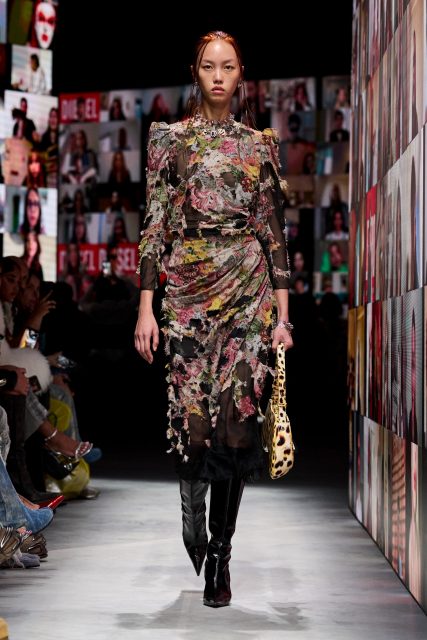In the Miuccia Prada profile in the March issue of this magazine, her co-creative director Raf Simons talks about their design process. “Anything can be a starting point, he said, “whether we love it or hate it or think it’s silly or funny or sad or stupid or political.” This season, their starting point was, of all things, the bow.
The black shift that marched out first today was bedecked with a couple dozen of them. Baby pink and deep purple versions of the dress came later, as did many further iterations of the bow, including at the back of skirts that were sturdy tweed in front and embroidered silk in back, as if their wearers had tied an apron over their underslip. (There was a lot of this kind of different-coming-than-going construction; much of the collection looked quite distinct front-to-back.)
Prada has never been one for the silly, funny, or stupid, so was there something political in this reclamation project? In the backstage crush, the designers talked about romance, love, and emotion, as well as history. “History teaches you everything. Especially in difficult moments,” Prada said in a press statement. “This is a collection shaped by history. It’s not about nostalgia, it’s about understanding.”
Bows have been the subject of much online discourse of late, partly because fashion has seen an inordinate amount of them in recent seasons, and partly because they’ve been taken up by the TikTok generation as a girlish affectation, a way to hold onto youth and reject adult responsibility, apparently. Vogue’s Prada profile is relevant here; she told the writer Wendell Steavenson, “It’s strange, because, every single morning I have to decide if I am a 15-year-old girl or an old lady.”
When the present feels tough and scary, and the future outlook even bleaker, the past comes up for everybody. It wasn’t just bows that Prada and Simons were playing with. There were letterman jackets with “P” patches on the chest and the year of Prada’s founding, 1913, stitched on the arms; there were sweater girl twinsets in mismatched colors worn with knee- and midi-length skirts that would’ve been prim, swanny, if you like, if not for their geometric seamed construction; and there were more of those vintage-look slips with scrollwork trimming their hems and seams.
The models wore their bags suspended from mini-belts in the crooks of their arms and held their hands to their chests, an old-fashioned gesture in the age of clutched iPhones. If that did indeed seem nostalgic, the 1950s couture-ish cocktail dresses at the end of the show made with technical high performance fabric and matching gloves were fine examples of Prada and Simons’s gift for repurposing familiar, even banal, tropes into pieces that look new and desirable. Not only that: something about that indestructible fabric felt a little bit political (don’t know about you, but that’s what I want from Prada) and quite right for this moment.
Editor
Nicole PhelpsCredit
Lead image: Isidore Montag / Gorunway.com

